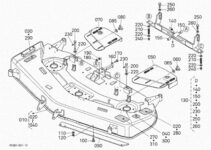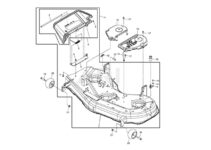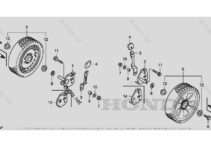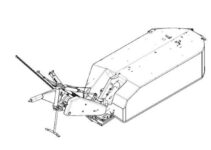The John Deere L130 lawn mower is the bigger version of the John Deere L110 and L120 lawn mowers. It is more comprehensive and sophisticated compared to the other two. The significant difference lies in the lawn mower’s dimensions and engine power.
Your L130 lawn mower can be safe from potential problems when you understand how it works. Learning about components makes you maintain a good maintenance culture and even diagnose issues quickly.
This guide will reveal this lawn mower’s diagram and discuss the components’ functions explicitly.
John Deere L130 Parts Diagram
A typical lawn tractor contains several components, and the John Deere L130 is no exception. It’s made up of many individual parts, including numerous machined and formed parts, subassemblies, and standard hardware working together.
Below is a diagram showing the components of the John Deere L130 lawn tractor:
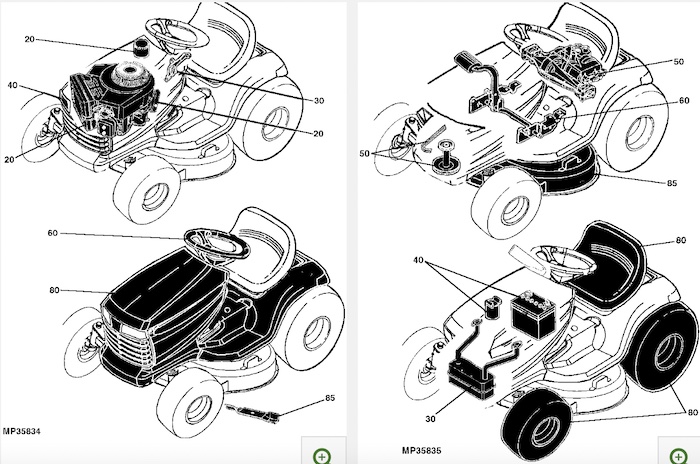
- Engine
- Fuel and Air
- Electrical
- Steering and Brakes
- Wheels, Brakes, and Operators Station
- Lower Deck and lift Linkages
John Deere L130 Parts Explained
The diagram above only shows the central part of the lawn mower. Each element has sub-categories and comprises different components that make them up. For instance, the engine consists of parts including a gasket kit, crankshaft, piston, cylinder head, and oil pump and filter.
Generally, other sub-parts of the John Deere L130 mower include:
- Engine Cover
- Strokes
- Wiring Harness
- Flywheel
- Starter
- Battery and Cables
- Solenoid Kit
- Muffler
- Air cleaner
- Fuel Tank
- Carburetor
- Fuel Filter
- Fuel Pump
Let’s delve deep into the functions of some of the most crucial parts.
Chassis
The chassis is a lawnmower’s main body. It facilitates the wheels and other mechanical components and housing of the engine. The chassis also aids in preventing injuries to the driver from the blades.
Most lawn mower models have a metal chassis, but some may also have an aluminum or plastic chassis. The efficiency of the lawnmower is unaffected by the chassis’s material. Steel is less likely to break or bend in an accident because it is more resilient than plastic or aluminum.
Crankshaft
The crankshaft is another vital component situated at the bottom of the engine. It rotates the wheels or blades of the instrument. It functions as the internal combustion engine’s skeleton. The crankshaft converts a linear motion into a rotational motion, which is necessary for the machine to function correctly.
In an engine, combustion pushes the piston down into the cylinder, rotating the crankshaft, which turns the blades of your lawnmower. A good crankshaft will have high-wear resistance and fatigue strength to ensure exceptional service life.
Air Filter
The air filter guards against dirt and debris getting into the engine’s internal workings. Additionally, the air cleaner prevents debris from entering the carburetor, enabling an unhindered flow of air and gasoline.
Although the lawn mower engine will still run without an air cleaner, dirt and other contaminants will quickly ruin the internal parts and cause them to malfunction.
Flywheel
The function of the flywheel in automobile engines is to provide energy for the pistons’ compression stroke and to smooth out the energy pulses created by the combustion in the cylinders.
Simply put, it keeps the crankshaft rotating between the engine’s power strokes by storing the momentum from combustion. When the energy source applies torque, the flywheel stores energy; once the energy system does not use torque, the flywheel discharges the stored energy.
Generally, the flywheel has three specific functions: Balance the engine, ensure it starts and stabilize the engine’s movement to reduce drivetrain stress reduction.
Carburetor
The component that supplies fuel to the combustion chamber is known as a carburetor. Standard and semi-injection carburetors are the two main types commonly used in lawnmowers. A distinctive fuel pump is present in semi-injected carburetors.
Muffler
Each exhaust stroke of a small engine forces hot gasses out of the cylinder, which produces noise. The purpose of the muffler is to lessen the noise made by the exhaust and stop your lawn mower from backfiring. It prevents leaves, debris, and dry grass from igniting in the exhaust spaces.
While you may run your lawn tractor without a muffler, it’s only sometimes recommended. It would help if you tried to wear ear protection while at it because the engine will run louder. However, operating a lawn mower without a muffler should not be done over the long haul as it may harm the engine’s valves.
Spark Plug
A spark is required in the combustion chamber to catalyze the fuel-air mixture. When the engine piston is nearly at the top of its stroke, an electrical current provides energy to the plug to produce a spark.
Heat Shields
Internal combustion engines generate a large amount of heat, hence heat shields’ importance. They are used on most machines to protect the chassis, bodywork, or other components from heat damage.
